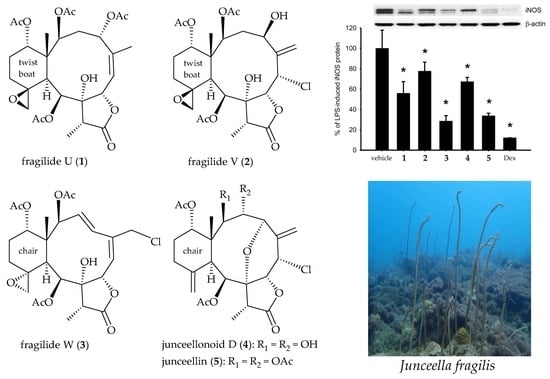Fragilides U–W: New 11,20-Epoxybriaranes from the Sea Whip Gorgonian Coral Junceella fragilis
Abstract
1. Introduction
2. Results and Discussion
3. Materials and Methods
3.1. General Experimental Procedures
3.2. Animal Material
3.3. Extraction and Isolation
3.4. In Vitro Anti-Inflammatory Assay
4. Conclusions
Supplementary Materials
Author Contributions
Funding
Conflicts of Interest
References
- Bayer, F.M. Key to the genera of octocorallia exclusive of Pennatulacea (Coelenterata: Anthozoa), with diagnoses of new taxa. Proc. Biol. Soc. Wash. 1981, 94, 902–947. [Google Scholar]
- Bayer, F.M.; Grasshoff, M. The genus group taxa of the family Ellisellidae, with clarification of the genera established by J.E. Gray (Cnidaria: Octocorallia). Senckenb. Biol. 1994, 74, 21–45. [Google Scholar]
- Chen, C.-C.; Chang, K.-H. Gorgonacea (Coelenterata: Anthozoa: Octocorallia) of Southern Taiwan. Bull. Inst. Zool. Acad. Sin. 1991, 30, 149–181. [Google Scholar]
- Chung, H.-M.; Wang, Y.-C.; Tseng, C.-C.; Chen, N.-F.; Wen, Z.-H.; Fang, L.-S.; Hwang, T.-L.; Wu, Y.-C.; Sung, P.-J. Natural product chemistry of gorgonian corals of genus Junceella—Part III. Mar. Drugs 2018, 16, 339. [Google Scholar] [CrossRef] [PubMed]
- Qi, S.-H.; Zhang, S.; Wen, Y.-M.; Xiao, Z.-H.; Li, Q.-X. New briaranes from the South China Sea gorgonian Junceella fragilis. Helv. Chim. Acta 2005, 88, 2349–2354. [Google Scholar] [CrossRef]
- Lin, Y.; Long, K. Studies of the chemical constituents of the Chinese gorgonia (IV)-Junceella, a new chlorine-containing diterpenoid from Junceella squamata. Acta Sci. Nat. Univ. Sunyatseni 1983, (2), 46–51. [Google Scholar]
- Yao, J.; Qian, J.; Fan, H.; Shih, K.; Huang, S.; Lin, Y.; Long, K. The structure of crystal and molecule of junceellin. Acta Sci. Nat. Univ. Sunyatseni 1984, (1), 83–87. [Google Scholar]
- Shin, J.; Park, M.; Fenical, W. The junceellolides, new anti-inflammatory diterpenoids of the briarane class from the Chinese gorgonian Junceella fragilis. Tetrahedron 1989, 45, 1633–1638. [Google Scholar] [CrossRef]
- Subrahmanyam, C.; Kulatheeswaran, R.; Ward, R.S. Briarane diterpenes from the Indian Ocean gorgonian Gornonella umbraculum. J. Nat. Prod. 1998, 61, 1120–1122. [Google Scholar] [CrossRef]
- García, M.; Rodríguez, J.; Jiménez, C. Absolute structures of new briarane diterpenoids from Junceella fragilis. J. Nat. Prod. 1999, 62, 257–260. [Google Scholar] [CrossRef]
- Qi, S.-H.; Zhang, S.; Huang, H.; Xiao, Z.-H.; Huang, J.-S.; Li, Q.-X. New briaranes from the South China Sea gorgonian Junceella juncea. J. Nat. Prod. 2004, 67, 1907–1910. [Google Scholar] [CrossRef] [PubMed]
- Sung, P.-J.; Fan, T.-Y.; Fang, L.-S.; Wu, S.-L.; Li, J.-J.; Chen, M.-C.; Cheng, Y.-M.; Wang, G.-H. Briarane derivatives from the gorgonian coral Junceella fragilis. Chem. Pharm. Bull. 2003, 51, 1429–1431. [Google Scholar] [CrossRef] [PubMed]
- Sung, P.-J.; Fan, T.-Y.; Chen, M.-C.; Fang, L.-S.; Lin, M.-R.; Chang, P.-C. Junceellin and praelolide, two briaranes from the gorgonian corals Junceella fragilis and Junceella juncea (Ellisellidae). Biochem. Syst. Ecol. 2004, 32, 111–113. [Google Scholar] [CrossRef]
- Liaw, C.-C.; Shen, Y.-C.; Lin, Y.-S.; Hwang, T.-L.; Kuo, Y.-H.; Khalil, A.T. Frajunolides E–K, briarane diterpenes from Junceella fragilis. J. Nat. Prod. 2008, 71, 1551–1556. [Google Scholar] [CrossRef] [PubMed]
- Lin, C.-C.; Chen, W.-F.; Lee, G.-H.; Wen, Z.-H.; Fang, L.-S.; Kuo, Y.-H.; Lee, C.-Y.; Sung, P.-J. Fragilides M–O, new triacetoxybriaranes from the gorgonian coral Junceella fragilis (Ellisellidae). Heterocycles 2019, 98, 984–993. [Google Scholar]
- Sheu, J.-H.; Chen, Y.-P.; Hwang, T.-L.; Chiang, M.Y.; Fang, L.-S.; Sung, P.-J. Junceellolides J–L, 11,20- epoxybriaranes from the gorgonian coral Junceella fragilis. J. Nat. Prod. 2006, 69, 269–273. [Google Scholar] [CrossRef] [PubMed]
- Tanaka, C.; Yamamoto, Y.; Otsuka, M.; Tanaka, J.; Ichiba, T.; Marriott, G.; Rachmat, R.; Higa, T. Briarane diterpenes from two species of octocorals, Ellisella sp. and Pteroeides sp. J. Nat. Prod. 2004, 67, 1368–1373. [Google Scholar] [CrossRef]
- Sung, P.-J.; Chiang, M.Y.; Tsai, W.-T.; Su, J.-H.; Su, Y.-M.; Wu, Y.-C. Chlorinated briarane-type diterpenoids from the gorgonian coral Ellisella robusta (Ellisellidae). Tetrahedron 2007, 63, 12860–12865. [Google Scholar] [CrossRef]
- Chang, J.-Y.; Liaw, C.-C.; Fazary, A.E.; Hwang, T.-L.; Shen, Y.-C. New briarane diterpenoids from the gorgonian coral Junceella juncea. Mar. Drugs 2012, 10, 1321–1330. [Google Scholar] [CrossRef]
- Liaw, C.-C.; Lin, Y.-C.; Lin, Y.-S.; Chen, C.-H.; Hwang, T.-L.; Shen, Y.-C. Four new briarane diterpenoids from Taiwanese gorgonian Junceella fragilis. Mar. Drugs 2013, 11, 2042–2053. [Google Scholar] [CrossRef]
- Sung, P.-J.; Wang, S.-H.; Chiang, M.Y.; Su, Y.-D.; Chang, Y.-C.; Hu, W.-P.; Tai, C.-Y.; Liu, C.-Y. Discovery of new chlorinated briaranes from Junceella fragilis. Bull. Chem. Soc. Jpn. 2009, 82, 1426–1432. [Google Scholar] [CrossRef]
- Jean, Y.-H.; Chen, W.-F.; Sung, C.-S.; Duh, C.-Y.; Huang, S.-Y.; Lin, C.-S.; Tai, M.-H.; Tzeng, S.-F.; Wen, Z.-H. Capnellene, a natural marine compound derived from soft coral, attenuates chronic constriction injury-induced neuropathic in rats. Br. J. Pharmacol. 2009, 158, 713–725. [Google Scholar] [CrossRef] [PubMed]
- Jean, Y.-H.; Chen, W.-F.; Duh, C.-Y.; Huang, S.-Y.; Hsu, C.-H.; Lin, C.-S.; Sung, C.-S.; Chen, I.-M.; Wen, Z.-H. Inducible nitric oxide synthase and cyclooxygenase-2 participate in anti-inflammatory and analgesic effects of the natural marine compound lemnalol from Formosan soft coral Lemnalia cervicorni. Eur. J. Pharmacol. 2008, 578, 323–331. [Google Scholar] [CrossRef] [PubMed]
- Chen, L.-C.; Lin, Y.-Y.; Jean, Y.-H.; Lu, Y.; Chen, W.-F.; Yang, S.-N.; Wang, H.-M.D.; Jang, I.-Y.; Chen, I.-M.; Su, J.-H.; et al. Anti-inflammatory and analgesic effects of the marine- derived compound comaparvin isolated from the crinoid Comanthus bennetti. Molecules 2014, 19, 14667–14686. [Google Scholar] [CrossRef]
- Oliveira, T.; Figueiredo, C.A.; Brito, C.; Stavroullakis, A.; Prakki, A.; da Silva Velozo, E.; Nogueira-Filho, G. Effect of Allium cepa L. on lipopolysaccharide-stimulated osteoclast precursor cell viability, count, and morphology using 4′,6-diamidino-2-phenylindole-staining. Int. J. Cell Biol. 2014, 2014, 535789. [Google Scholar] [CrossRef]
- Cheng, W.; Li, X.; Yin, F.; van Ofwegen, L.; Lin, W. Halogenated briarane diterpenes with acetyl migration from the gorgonian coral Junceella fragilis. Chem. Biodiver. 2017, 14, e1700053. [Google Scholar] [CrossRef]
- Cheng, W.; Ji, M.; Li, X.; Ren, J.; Yin, F.; van Ofwegen, L.; Yu, S.; Chen, X.; Lin, W. Fragilolides A–Q, norditerpenoid and briarane diterpenoids from the gorgonian coral Junceella fragilis. Tetrahedron 2017, 73, 2518–2528. [Google Scholar] [CrossRef]
- Su, Y.-M.; Fan, T.-Y.; Sung, P.-J. 11,20-Epoxybriaranes from the gorgonian coral Ellisella robusta (Ellisellidae). Nat. Prod. Res. 2007, 21, 1085–1090. [Google Scholar] [CrossRef]
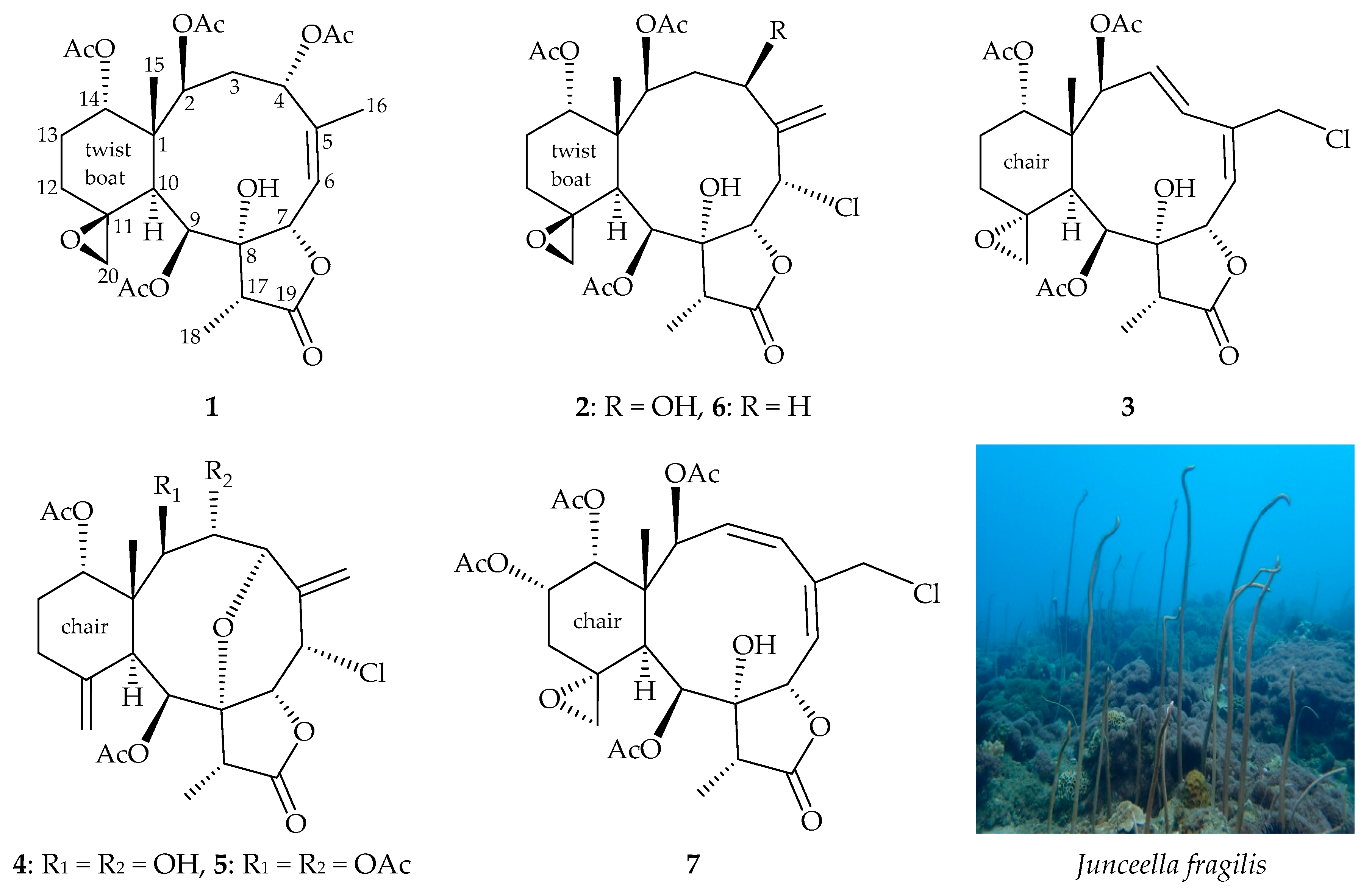
 ) correlations, selective heteronuclear multiple bond correlation (HMBC) experiment (
) correlations, selective heteronuclear multiple bond correlation (HMBC) experiment ( ), and protons with key nuclear Overhauser effect spectroscopy (NOESY) (
), and protons with key nuclear Overhauser effect spectroscopy (NOESY) ( ) correlations of 1.
) correlations of 1.
 ) correlations, selective heteronuclear multiple bond correlation (HMBC) experiment (
) correlations, selective heteronuclear multiple bond correlation (HMBC) experiment ( ), and protons with key nuclear Overhauser effect spectroscopy (NOESY) (
), and protons with key nuclear Overhauser effect spectroscopy (NOESY) ( ) correlations of 1.
) correlations of 1.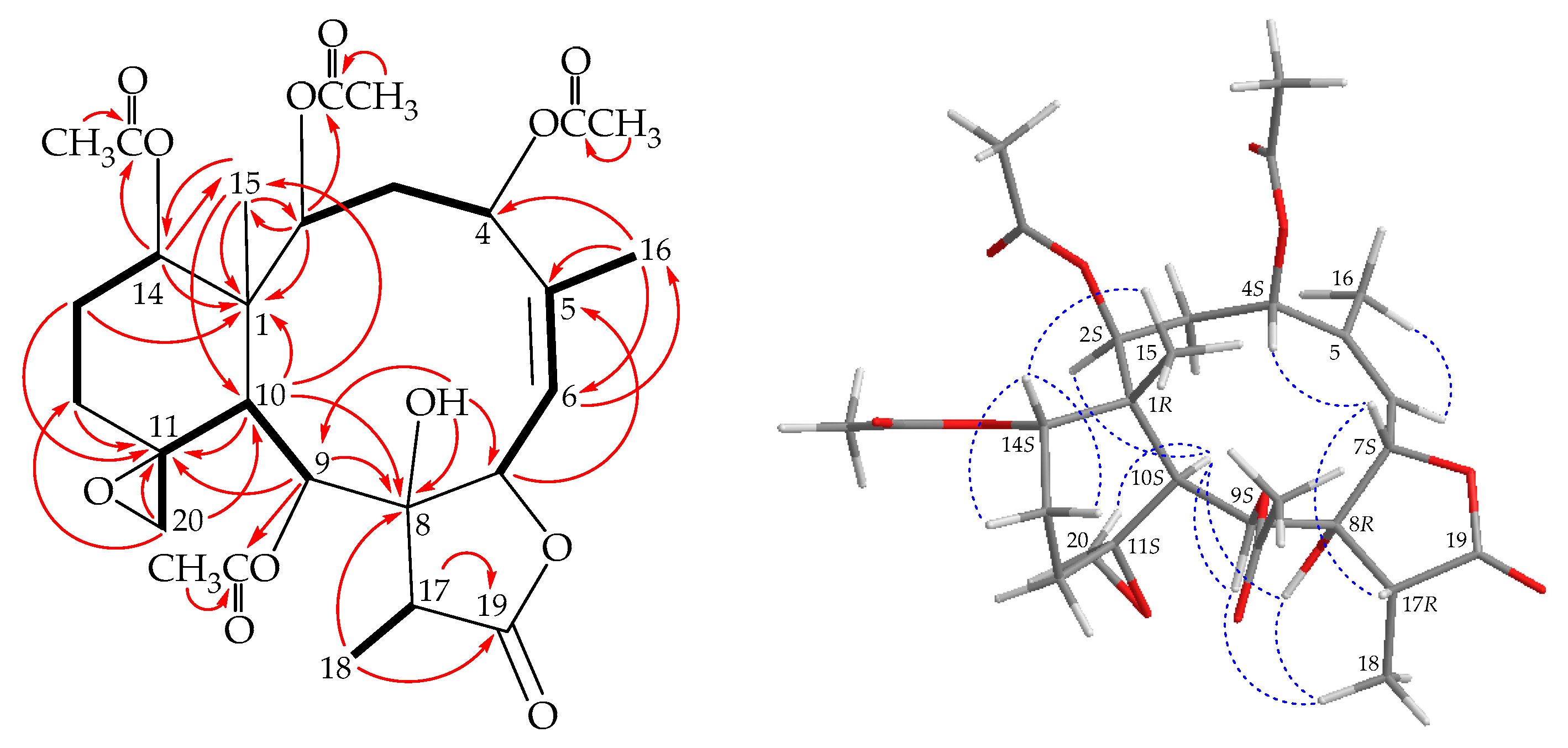
 ) correlations, selective HMBC (
) correlations, selective HMBC ( ), and protons with key NOESY (
), and protons with key NOESY ( ) correlations of 2.
) correlations of 2.
 ) correlations, selective HMBC (
) correlations, selective HMBC ( ), and protons with key NOESY (
), and protons with key NOESY ( ) correlations of 2.
) correlations of 2.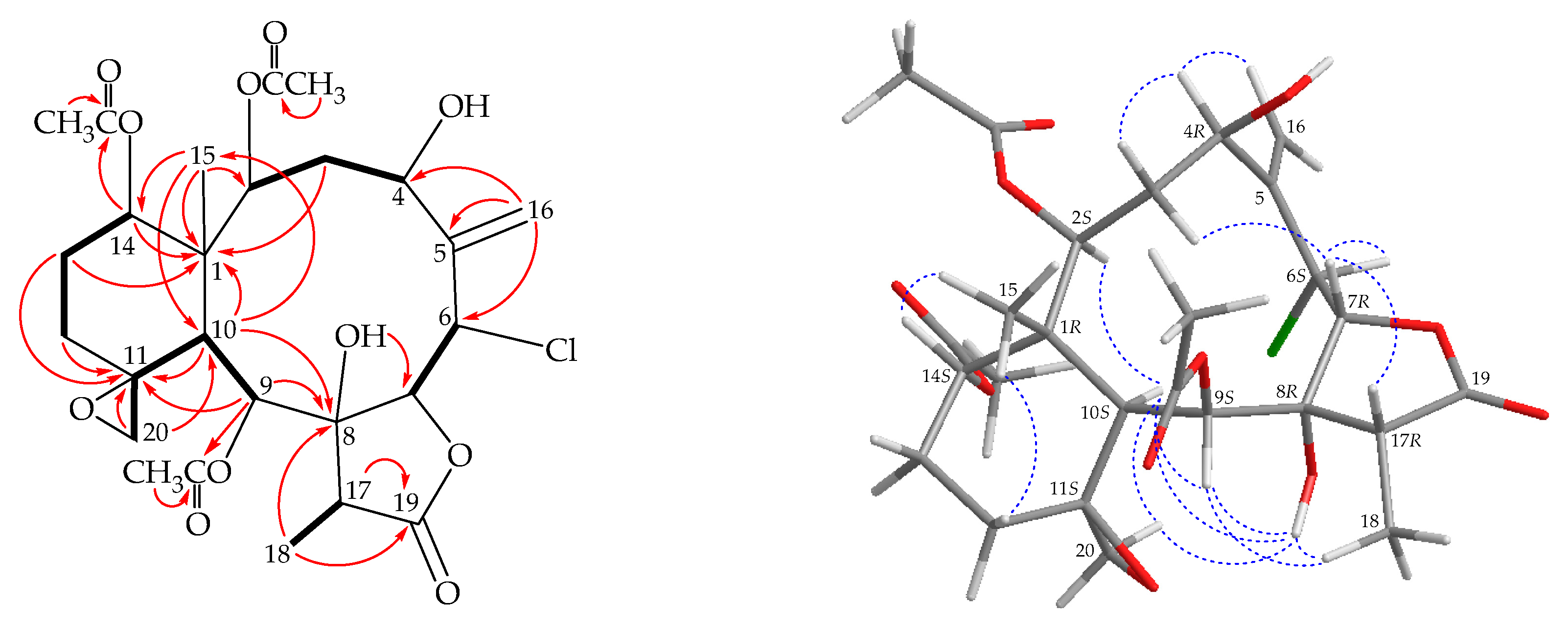
 ) correlations, selective HMBC (
) correlations, selective HMBC ( ), and protons with key NOESY (
), and protons with key NOESY ( ) correlations of 3.
) correlations of 3.
 ) correlations, selective HMBC (
) correlations, selective HMBC ( ), and protons with key NOESY (
), and protons with key NOESY ( ) correlations of 3.
) correlations of 3.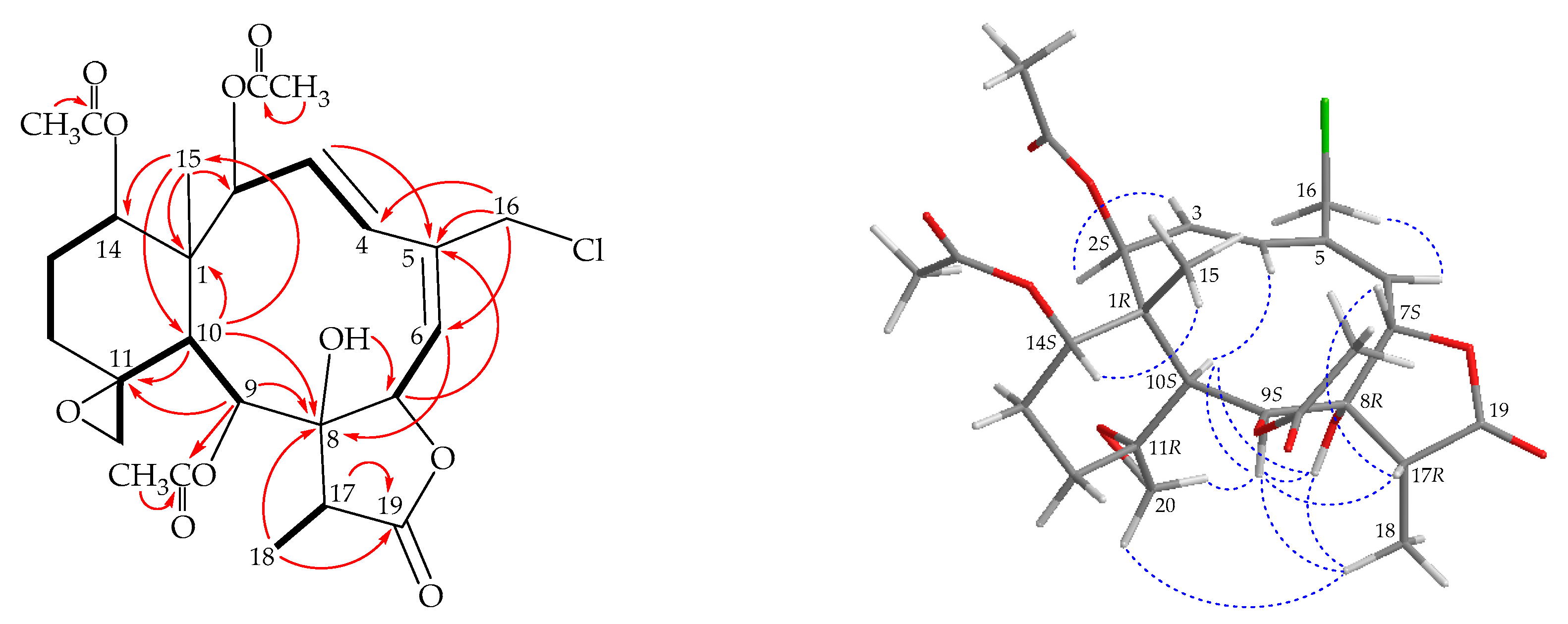
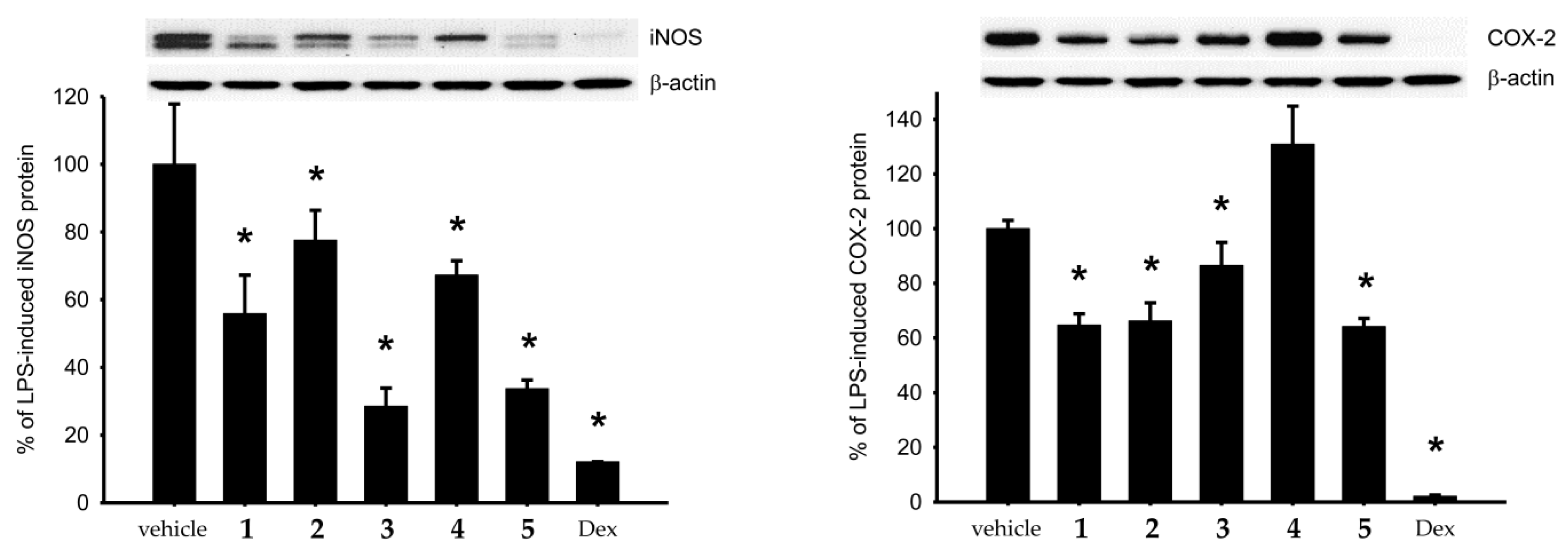
| Position | 1 a | 2 a | 3 b |
|---|---|---|---|
| 1 | 47.0, C c | 46.1, C | 49.1, C |
| 2 | 72.2, CH | 72.1, CH | 75.4, CH |
| 3 | 37.5, CH2 | 37.6, CH2 | 136.4, CH |
| 4 | 70.6, CH | 73.4, CH | 128.2, CH |
| 5 | 142.0, C | 144.1, C | 135.9, C |
| 6 | 120.6, CH | 58.0, CH | 128.8, CH |
| 7 | 76.5, CH | 79.0, CH | 80.0, CH |
| 8 | 80.4, C | 81.9, C | 80.9, C |
| 9 | 67.4, CH | 68.9, CH | 67.1, CH |
| 10 | 39.9, CH | 39.8, CH | 39.5, CH |
| 11 | 62.5, C | 62.6, C | 60.8, C |
| 12 | 23.6, CH2 | 23.5, CH2 | 29.4, CH2 |
| 13 | 24.2, CH2 | 24.0, CH2 | 25.5, CH2 |
| 14 | 73.2, CH | 73.5, CH | 78.9, CH |
| 15 | 14.6, CH3 | 15.4, CH3 | 16.0, CH3 |
| 16 | 21.4, CH3 | 121.0, CH2 | 48.0, CH2 |
| 17 | 42.4, CH | 43.8, CH | 45.2, CH |
| 18 | 6.6, CH3 | 7.1, CH3 | 6.9, CH3 |
| 19 | 175.9, C | 175.2, C | 174.8, C |
| 20 | 59.1, CH2 | 58.2, CH2 | 50.4, CH2 |
| Acetate methyls | 21.7, CH3 | 21.9, CH3 | 21.7, CH3 |
| 21.2, CH3 | 21.0, CH3 | 21.4, CH3 | |
| 20.9, CH3 | 21.0, CH3 | 21.3, CH3 | |
| 20.8, CH3 | |||
| Acetate carbonyls | 170.1, C | 171.0, C | 170.4, C |
| 169.8, C | 170.1, C | 169.7, C | |
| 169.4, C | 169.7, C | 169.3, C | |
| 169.0, C |
| Position | 1 a | 2 a | 3 b |
|---|---|---|---|
| 2 | 5.03 br s | 4.96 dd (2.8, 2.8) | 5.63 d (6.0) |
| 3α/β | 2.04 m; 2.62 ddd (18.4, 4.0, 2.4) | 1.75 m; 2.38 m | 6.04 dd (17.4, 6.0) |
| 4 | 5.91 br s | 4.85 m | 6.42 d (17.4) |
| 6 | 5.67 dq (8.8, 1.6) | 5.49 br s | 5.66 d (3.6) |
| 7 | 5.04 d (8.8) | 5.15 d (2.4) | 5.62 d (3.6) |
| 9 | 5.65 d (5.6) | 5.52 d (6.4) | 4.77 d (6.6) |
| 10 | 2.36 dd (5.6, 1.6) | 2.31 d (6.4) | 3.32 d (6.6) |
| 12α/β | 1.13 m; 2.30 m | 1.15 m; 2.30 m | 1.29 m; 2.18 m |
| 13α/β | 2.11 m; 1.81 m | 2.14 m; 1.78 m | 2.08 m; 1.85 dddd (12.0, 12.0, 3.6, 1.8) |
| 14 | 4.71 d (4.8) | 4.86 d (4.4) | 4.94 dd (3.6, 3.0) |
| 15 | 1.09 s | 1.13 s | 0.87 s |
| 16a/b | 2.00 d (1.6) | 5.74 s; 5.97 s | 4.13 d (12.0); 4.19 d (12.0) |
| 17 | 2.33 q (7.6) | 2.29 q (7.6) | 2.36 q (7.2) |
| 18 | 1.15 d (7.6) | 1.22 d (7.6) | 1.18 d (7.2) |
| 20a/b | 2.85 d (4.4); 2.98 dd (4.4, 1.6) | 2.83 d (4.0); 2.85 br d (4.0) | 2.76 d (2.4); 3.40 dd (2.4, 2.4) |
| OH-8 | 4.85 br s | 4.63 br s | 3.13 d (1.2) |
| Acetate methyls | 2.24 s | 2.23 s | 2.27 s |
| 2.01 s | 2.03 s | 2.25 s | |
| 1.99 s | 1.99 s | 2.11 s | |
| 1.98 s |
| iNOS | COX-2 | β-Actin | |
|---|---|---|---|
| Compound | Expression (% of LPS) | ||
| Lipopolysaccharides | 100.01 ± 17.81 | 100.00 ± 3.04 | 100.00 ± 6.05 |
| 1 | 55.88 ± 11.42 | 64.73 ± 4.07 | 90.05 ± 7.11 |
| 2 | 77.58 ± 8.82 | 66.23 ± 6.59 | 99.29 ± 5.24 |
| 3 | 28.55 ± 5.35 | 86.46 ± 8.46 | 101.69 ± 6.46 |
| 4 | 67.25 ± 4.27 | 130.88 ± 13.94 | 103.20 ± 2.56 |
| 5 | 33.72 ± 2.57 | 64.15 ± 3.03 | 84.52 ± 7.78 |
| Dexamethasone | 12.11 ± 0.03 | 2.11 ± 0.44 | 123.86 ± 2.99 |
© 2019 by the authors. Licensee MDPI, Basel, Switzerland. This article is an open access article distributed under the terms and conditions of the Creative Commons Attribution (CC BY) license (http://creativecommons.org/licenses/by/4.0/).
Share and Cite
Su, T.-P.; Yuan, C.-H.; Jhu, Y.-M.; Peng, B.-R.; Wen, Z.-H.; Wu, Y.-J.; Wu, T.-Y.; Liu, H.-W.; Sung, P.-J. Fragilides U–W: New 11,20-Epoxybriaranes from the Sea Whip Gorgonian Coral Junceella fragilis. Mar. Drugs 2019, 17, 706. https://doi.org/10.3390/md17120706
Su T-P, Yuan C-H, Jhu Y-M, Peng B-R, Wen Z-H, Wu Y-J, Wu T-Y, Liu H-W, Sung P-J. Fragilides U–W: New 11,20-Epoxybriaranes from the Sea Whip Gorgonian Coral Junceella fragilis. Marine Drugs. 2019; 17(12):706. https://doi.org/10.3390/md17120706
Chicago/Turabian StyleSu, Tung-Pin, Chien-Han Yuan, Yi-Ming Jhu, Bo-Rong Peng, Zhi-Hong Wen, Yu-Jen Wu, Tung-Ying Wu, Hong-Wen Liu, and Ping-Jyun Sung. 2019. "Fragilides U–W: New 11,20-Epoxybriaranes from the Sea Whip Gorgonian Coral Junceella fragilis" Marine Drugs 17, no. 12: 706. https://doi.org/10.3390/md17120706
APA StyleSu, T.-P., Yuan, C.-H., Jhu, Y.-M., Peng, B.-R., Wen, Z.-H., Wu, Y.-J., Wu, T.-Y., Liu, H.-W., & Sung, P.-J. (2019). Fragilides U–W: New 11,20-Epoxybriaranes from the Sea Whip Gorgonian Coral Junceella fragilis. Marine Drugs, 17(12), 706. https://doi.org/10.3390/md17120706





